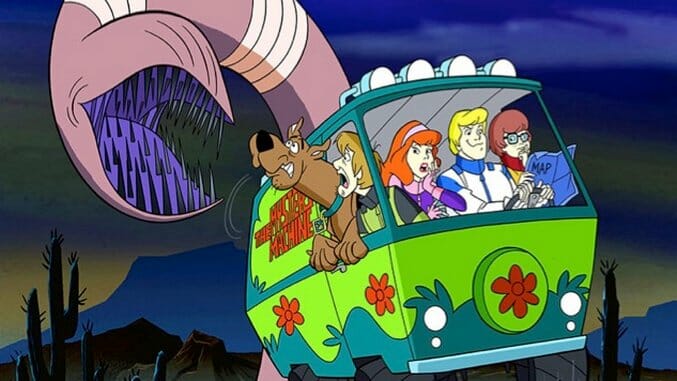The Evolution of Scooby-Doo, One of TV’s Greatest Tributes to the Open Road

Imagine, for a moment, you and your teenaged friends are cruising down the streets, probably at night. You’re going about your business, when you stumble upon, say, an abandoned amusement park, or a creepy, decrepit mansion. What do you do? Probably just keep driving, right? But, what if you found out that there was, say, a pirate ghost hanging out in one of these places? What then? If you are the gang from any of the various Scooby-Doo programs, then you realize that there is a mystery to solve, and that there’s nothing to fear but crooked real estate developers.
Generally speaking, people only think of Scooby-Doo as a goofy little cartoon about a gang of mystery-solving teenagers. However, in many ways, it’s concept is akin to shows such as Kung Fu or Have Gun, Will Travel. The gang, known in some iterations as Mystery Incorporated, are a roving crew of problem solvers. They show up, they find out about some sort of haunting-related mystery, and then they solve it, usually with some humorous bits along the way. All the while, they drive around in the Mystery Machine, a psychedelic van that is a product of the time of its inception.
Since the original version of the show, Scooby-Doo, Where Are You?, which began in 1969, there have been several different versions of the show, on a handful of networks. Even now, there is a new iteration, Be Cool, Scooby-Doo! on Cartoon Network. The core of the show has always remained the same. Four teens, and their talking Great Dane Scooby-Doo, drive around in Fred’s van in hopes of finding a mystery to solve. Sure, they aren’t traveling around the country, but essentially every episode, especially the earlier episodes, shows Mystery Incorporated on the road, headed somewhere. Sometimes, they aren’t even looking for a mystery. The mystery comes to them.
Scooby-Doo, Where Are You? is probably, still, the most well-known version of the show. It’s your traditional kitschy Hanna-Barbara show, with its cheap animation and repetitious backgrounds. It only ran for 25 episodes, but those episodes have been repeated over and over, for decades now. It set the parameters for all future variations on this particular theme, which is why Shaggy has always looked like a ‘50s style beatnik. It established the roles of all the characters, and the fact that, in the end, basically the only other character from the episode turns out to be the bad guy.
This earliest version of the show wasn’t good. It was a cheap, chintzy cartoon churned out to entertain children, only really worth it for the camp value, and only, eventually, venerated for beginning such a major pop culture entity. Scooby-Doo, Where Are You? gave way to The New Scooby-Doo Movies, which was basically one-hour long episodes of the same show, but now, with the likes of the Harlem Globetrotters or Don Knotts getting involved. It was insane.
After this, the Scooby gang moved from CBS to ABC for The Scooby-Doo Show. This version of the show ran for 40 episodes, even though it is not remembered as well as Scooby-Doo, Where Are You?
-

-

-

-

-

-

-

-

-

-

-

-

-

-

-

-

-

-

-

-

-

-

-

-

-

-

-

-

-

-

-

-

-

-

-

-

-

-

-

-








































